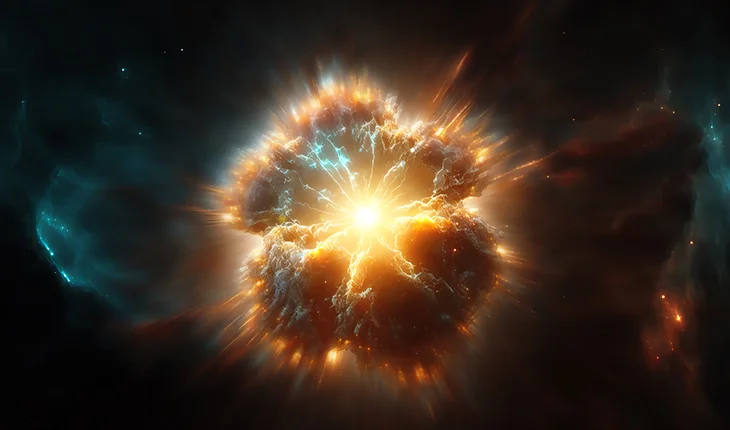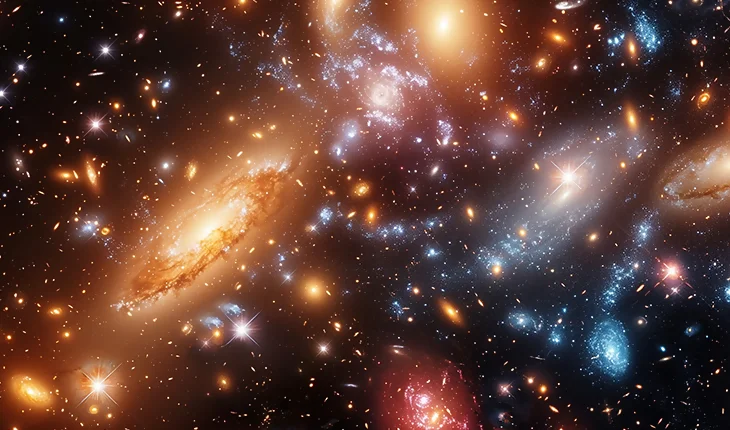Welcome to Spaceyv’s journey into the heart of one of the most spectacular events in the cosmos—the supernova explosion. Join us as we unravel the mysteries behind these celestial fireworks that illuminate the vastness of space and contribute to the dynamic evolution of our universe.
The Fiery Demise of Massive Stars
At the heart of a supernova lies the dramatic conclusion to the life of a massive star. When a massive star exhausts its nuclear fuel, gravitational forces cause a catastrophic collapse, leading to an intense release of energy and the birth of a supernova.
Illumination of the Cosmos with Intense Energy
The explosion of a supernova releases an astonishing amount of energy, briefly outshining entire galaxies. The burst of light emitted during this cataclysmic event can be billions of times brighter than the host star, briefly turning the fading star into a celestial beacon that captivates observers across the universe.
Related Content:
14 Interesting Astronomy Facts
Formation of Nebulae and Pulsars
As the remnants of a supernova expand into space, they give rise to some of the most captivating structures in the cosmos. The shockwaves from the explosion often trigger the formation of nebulae—vast clouds of gas and dust that serve as the cosmic nurseries for new stars. Additionally, the core left behind after a supernova may collapse into a pulsar, a highly magnetized and rapidly rotating neutron star emitting beams of electromagnetic radiation.
The Cosmic Detective: Unraveling the Universe’s Mysteries
Supernovae play a crucial role as cosmic detectives, offering valuable insights into the fundamental properties of the universe. By studying the light emitted during these explosions, astronomers can determine the composition of elements produced in the star’s core, providing a cosmic fingerprint that deepens our understanding of stellar processes.

Types of Supernovae
1. Type Ia Supernovae:
Mechanism:
- White Dwarf Explosion: Type Ia supernovae originate in binary star systems where one star is a white dwarf—a dense remnant of a star that has exhausted its nuclear fuel.
- Accumulation of Mass: The white dwarf accumulates matter from its companion star until it reaches a critical mass, known as the Chandrasekhar limit (about 1.4 times the mass of the Sun).
- Thermonuclear Explosion: As the white dwarf approaches this limit, the intense heat and pressure at its core trigger a runaway thermonuclear explosion, obliterating the star.
Characteristics:
- Uniform Brightness: Type Ia supernovae are known for their consistent brightness, making them valuable as “standard candles” for measuring astronomical distances.
- Rich in Iron: The spectra of Type Ia supernovae reveal a high abundance of iron, indicating the fusion of lighter elements during the explosion.
Significance:
- Cosmic Distance Indicators: Because of their consistent brightness, Type Ia supernovae are crucial in measuring distances across the universe, helping astronomers map the large-scale structure of the cosmos.
- Cosmic Acceleration Discovery: The discovery of the accelerating expansion of the universe was attributed to the observation of distant Type Ia supernovae.
2. Core-Collapse Supernovae (Type II):
Mechanism:
- Massive Star Demise: Core-collapse supernovae occur when a massive star, typically at least eight times the mass of the Sun, exhausts its nuclear fuel.
- Iron Core Formation: As the star’s core fuses elements, it eventually forms iron, which cannot sustain nuclear reactions. The core collapses under gravity’s pull.
Characteristics:
- Diverse Spectra: Type II supernovae exhibit diverse spectra, indicating variations in the elements present, such as hydrogen, helium, and heavier elements produced during the explosion.
- Massive Stellar Remnant: The remnants of Type II supernovae can form neutron stars or, in more massive cases, collapse into black holes.
Subtypes:
- Type II-P (Plateau): These supernovae display a distinctive plateau in their light curves, indicating a steady brightness for an extended period before fading.
- Type II-L (Linear): Type II-L supernovae lack a prominent plateau, with their light curves decreasing more rapidly after the initial peak.
Significance:
- Galactic Enrichment: Core-collapse supernovae are crucial for enriching galaxies with heavier elements, as the explosion disperses newly formed elements into space, providing the raw materials for future star formation.
- Supernova Remnant Formation: The remnants of core-collapse supernovae contribute to the formation of nebulae and supernova remnants, influencing the structure and dynamics of interstellar environments.
Understanding the distinctions between these types of supernovae enhances our grasp of stellar life cycles, cosmic chemical evolution, and the broader evolution of the universe.
Where to Witness this supernova explosion Phenomena
Witnessing a supernova directly from Earth is a rare event, as they are unpredictable and can occur in distant galaxies. However, various observatories, both ground-based and space-based, continually monitor the sky, capturing these cosmic explosions. Here’s more information on where to stay updated on supernova occurrences:
1. Ground-Based Observatories:
- Palomar Observatory, California, USA:
- Home to the Zwicky Transient Facility (ZTF), which scans the sky for transient phenomena, including supernovae.
- Provides real-time data for astronomers and the public to explore.
- Las Cumbres Observatory, Global Network:
- Operates a network of telescopes around the world, allowing continuous observation of the night sky.
- Enables astronomers to monitor and follow up on transient events, including supernovae.
- European Southern Observatory (ESO), Chile:
- Houses powerful telescopes like the Very Large Telescope (VLT) and the upcoming Extremely Large Telescope (ELT).
- Provides astronomers with the capability to study supernovae in detail.
2. Space-Based Telescopes:
- NASA’s Hubble Space Telescope:
- Continuously observes the universe from orbit, providing high-resolution images and data on supernovae and other celestial phenomena.
- NASA’s Chandra X-ray Observatory:
- Captures X-ray emissions from supernova remnants, offering insights into the high-energy processes associated with these explosions.
- The Zwicky Transient Facility (ZTF):
- Located at Palomar Observatory, ZTF is designed to discover and characterize transients, including supernovae, in real time.
3. Online Databases and Citizen Science Projects:
- The Open Supernova Catalog:
- A collaborative project providing a comprehensive, open-access database of supernova observations.
- Zooniverse – Supernova Hunters:
- Citizen science project allowing individuals to contribute to the discovery and classification of supernovae.
- The Transient Name Server (TNS):
- Offers real-time transient astronomical event data, including supernova discoveries.
By exploring these observatories, telescopes, and online resources, astronomy enthusiasts and researchers can stay informed about the latest supernova discoveries and contribute to our understanding of these cosmic events. Keep an eye on news from these platforms to witness the unveiling of new supernovae and gain valuable insights into the dynamic nature of our universe.
The Eternal Dance of Destruction and Creation
In the cosmic tapestry, supernovae represent the dynamic interplay between destruction and creation. The energy released during these colossal explosions molds the landscapes of the universe, shaping the destiny of galaxies and paving the way for new generations of stars.
As we peer into the cosmic tapestry, the brilliance of supernovae explosions serves as a testament to the eternal dance of destruction and creation in the vast theater of the universe. Through the lens of our observatories and the collective curiosity of humanity, we continue to unveil the mysteries hidden within the shimmering lights of these celestial fireworks, embracing the profound beauty and dynamic evolution of the cosmos.” – Spaceyv



